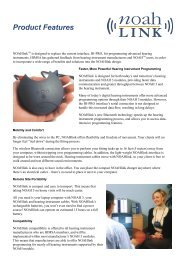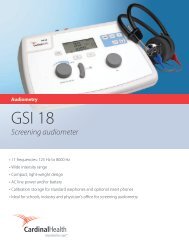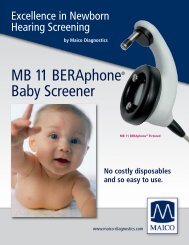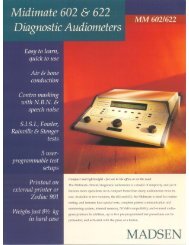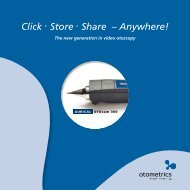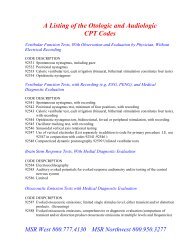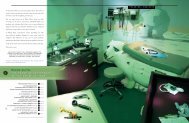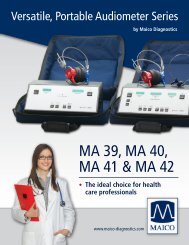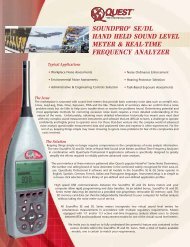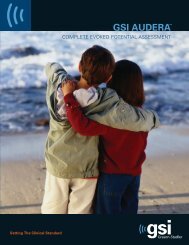ERO•SCAN
Eroâ¢Scan - Maico Diagnostic
Eroâ¢Scan - Maico Diagnostic
- No tags were found...
Create successful ePaper yourself
Turn your PDF publications into a flip-book with our unique Google optimized e-Paper software.
OAE Test System<br />
by Maico Diagnostics<br />
<strong>ERO•SCAN</strong><br />
EroScan Pictured<br />
• OAE Hearing Screener<br />
• DPOAE/TEOAE<br />
Test Systems<br />
www.maico-diagnostics.com
Ero•Scan - OAE Test System<br />
Visual Evaluation<br />
Middle Ear<br />
Evaluation<br />
Ideal for...<br />
Ear Canal<br />
Eardrum<br />
Tympanometric<br />
Evaluation<br />
Cochlea<br />
OAE Evaluation<br />
• Physicians<br />
• Pediatricians<br />
• Birth-to-3<br />
Programs<br />
• School & Head<br />
Start Programs<br />
• Nurseries<br />
Otoacoustic Emissions (OAEs)<br />
Otoacoustic emissions are sounds that are produced by the cochlea<br />
(outer hair cells) and can be measured in the ear canal. When sound<br />
passing through the ear canal reaches the cochlea, the vibration<br />
stimulates thousands of tiny hair cells. This creates a byproduct that<br />
can be detected and measured: otoacoustic emissions.<br />
OAEs only occur in a normal cochlea with normal hearing sensitivity.<br />
If there is damage to the outer hair cells, which produces hearing loss,<br />
then OAEs will not be present. In general, OAEs will be present if<br />
hearing is at 30 dB or better.<br />
PASS test results mean OAEs were detected. If there is damage<br />
to the outer hair cells producing a mild hearing loss, OAEs may<br />
not be present. The test result is REFER and the patient may be<br />
at risk for possible communication difficulties and can benefit<br />
from further diagnostic assessment.<br />
www.maico-diagnostics.com
Physicians<br />
Otoacoustic emissions testing is an ideal tool for hearing screening<br />
because it can quickly identify a possible hearing loss and signal<br />
referral for more comprehensive testing.<br />
Pediatricians<br />
Hearing loss is not always identified by newborn screening.<br />
Pediatricians are the first professionals the parents approach with<br />
concerns about their child’s hearing. Since hospital-based and private<br />
practice pediatricians screen infants and young children for hearing<br />
loss and middle ear disorders, incorporating OAEs into this routine<br />
testing can be greatly beneficial.<br />
Head Start and School Screening<br />
The Maico EroScan is an effective tool for Head Start and school<br />
programs as a means to document hearing testing as well as screen<br />
large numbers of children very quickly. Since there is no need for a<br />
behavioral response from the patient, it is easy to test ESL and<br />
special needs children.<br />
Utilizing OAEs<br />
• Follow-up infants from nursery screening<br />
and well-baby checks<br />
• Identify and monitor middle-ear pathology<br />
such as otitis media<br />
• Use with tympanometry to rule out middle<br />
ear pathology<br />
• Monitor cochlear function in those<br />
who are taking medication that is<br />
potentially ototoxic<br />
• Differentiate between organic and non-organic<br />
hearing loss<br />
• Identify educationally significant hearing loss<br />
• Detect late-onset hearing loss<br />
This procedure is also beneficial in assessing children that cannot be<br />
tested by conventional means. For example, pure tone audiometry<br />
requires a response from the child which may be an unrealistic<br />
expectation and time-consuming.
Ero•Scan Classic<br />
• DPOAE & TEOAE Combination<br />
Test System<br />
Managing Data<br />
The EroScan’s optional database integrates tests data into Hi-Track or OZ<br />
for state tracking. Using the database also gives you a means to create<br />
detailed, color reports in a letter-sized format that can be easily filed or<br />
faxed. You can also create a “paperless” office by saving the test results<br />
as a PDF for electronic filing or email.<br />
Diagnostic Testing<br />
The EroScan is an effective diagnostic testing tool for<br />
otologists, audiologists and otolaryngologists that provides<br />
objective information about hearing and middle ear status<br />
with only one test. Identify outer hair cell function in the<br />
cochlea, assess middle ear function and differentiate between<br />
organic and non-organic functional hearing loss. OAEs are<br />
also beneficial in assessing patients who cannot be tested<br />
by conventional means.<br />
www.maico-diagnostics.com
Utilizing OAEs<br />
An OAE test can contribute a valuable<br />
piece of clinical data towards your accurate<br />
diagnosis and has the following uses:<br />
• Differentiate possible cochlear versus<br />
retrocochlear pathology<br />
• Identify suspected malingering or<br />
non-pathological hearing loss<br />
• Identify autoimmune or sudden hearing loss<br />
• Monitor ototoxicity on the cochlea<br />
• Provide objective cochlear screening in both<br />
non-cooperative patients and cooperative<br />
patients where behavioral testing cannot<br />
be performed<br />
• Detect early signs of noise exposure in those<br />
who are exposed to high noise levels<br />
• Detect possible late-onset hearing loss<br />
• Screen for early effects of ischemia on<br />
the cochlea<br />
Reimbursement<br />
Otoacoustic emissions are reimbursable using the Current<br />
Procedural Terminology (CPT) codes. The most typical CPT code for<br />
OAE diagnostic.<br />
92587:<br />
Evoked otoacoustic emissions; limited (single stimulus<br />
level, either transient or distorted products). This is the<br />
most typical code and would be considered a<br />
“screening” code.<br />
92588:<br />
Comprehensive or diagnostic evaluation (comparison<br />
of transient and/or distortion product otoacoustic<br />
emissions at multiple levels and frequencies). This is<br />
for diagnostic OAE testing.
Ero•Scan Classic<br />
• DPOAE & TEOAE Combination<br />
Test System<br />
Test both ears in less than a minute<br />
Testing takes less than 30 seconds per ear.<br />
Results are displayed as PASS or REFER<br />
The easy-to-read results do not require interpretation.<br />
Managing data<br />
Printing color reports and tracking data is easy with the optional<br />
database software.<br />
State reporting<br />
The optional database integrates data into HiTRACK or OZ.<br />
Accurate results<br />
The patented EroScan noise algorithm allows for reliable testing in up<br />
to 70 dB of background noise which means fewer false REFER results.<br />
Portability<br />
The EroScan hand-held unit runs on batteries and allows you to<br />
move from room to room. The remote probe also makes it easy to<br />
maneuver around the head of your patient to attain a tight ear seal.<br />
Memory<br />
The EroScan contains memory to store complete tests for 50 ears.<br />
Print the results<br />
The included thermal printer will print the test results as soon as you<br />
replace the unit in its cradle for easy filing.<br />
Rubber Tips<br />
Rubber tips come in several sizes including the specially-designed<br />
newborn sizes shown below.<br />
Red treetop tip: Newborn<br />
Green mushroom tip: Newborn/youth – up to 9 months old<br />
Blue mushroom tip: Pediatric (various sizes)<br />
Yellow mushroom tip: Adult (various sizes)<br />
www.maico-diagnostics.com
Parts & Accessories<br />
The <strong>ERO•SCAN</strong> OAE System is available in three<br />
configurations: Screener, Standard and Diagnostic<br />
Combo System<br />
Cradle #586-5<br />
Probe Tips<br />
#586-2<br />
Carrying Case<br />
(optional accessory)<br />
#586-7<br />
Eartips<br />
#586-16<br />
Remote Probe<br />
#586-11<br />
Database Software<br />
(optional accessory)<br />
#586-12<br />
PRODUCT FEATURE <strong>ERO•SCAN</strong> SCREENER <strong>ERO•SCAN</strong> STANDARD <strong>ERO•SCAN</strong> COMBO<br />
DPOAE/TEOAE DP or TE DP or TE DP and TE<br />
Diagnostic (CPT)1 92588 N Y Y<br />
Printer Included Y Y Y<br />
Portable Y Y Y<br />
Internal Probe Y Y Y<br />
External Probe Y Y Y<br />
Maximum number of Test<br />
Frequencies or Bands Reported<br />
Frequency Range<br />
4 DP<br />
6 TE<br />
2-5 DP<br />
1.5-4 TE<br />
6 DP<br />
6 TE<br />
1.5-12 DP<br />
.7-4 TE<br />
6 DP<br />
6 TE<br />
1.5-12 DP<br />
.7-4 TE<br />
High Frequency DPs to 12 kHz N Y Y<br />
Default Pass/Refer Y Y Y<br />
# of Test Protocols 1 2 4<br />
Memory (# tests)/Maximum 50 50 50<br />
Tests All Ages Y Y Y<br />
Tests Patients with PE Tubes Y Y Y<br />
Customizable Test Protocols N Y Y<br />
Customizable Pass Criteria N Y Y<br />
Database Software (Cost Option) Optional Optional Optional<br />
Prints Numeric Data Y Y Y<br />
Prints Graphic Data Y Y Y<br />
Customizable Averaging Time Y Y Y<br />
Date/Time on Print-Out Y Y Y<br />
OZ Compatible Y Y Y<br />
HI*TRACK Compatible Y Y Y<br />
Customizable Parameters N Y Y<br />
Freq. Range (DPs and TEs) N Y Y<br />
Average Time (DPs and TEs) N Y Y<br />
# Freq. Tested (DPs) N Y Y<br />
All test protocol changes can be<br />
made through OAE unit alone<br />
(Additional software and computer NOT<br />
required to change protocols)<br />
Not Customizable Y Y<br />
Printer Paper<br />
#586-8<br />
Remote Probe Tips<br />
#586-14
Innovation,<br />
Continuity,<br />
Reliability,<br />
MAICO Product Line:<br />
• Screening Audiometers<br />
• Diagnostic Audiometers<br />
• Middle Ear Analyzers<br />
• OAE Test Systems<br />
• PC Compatible Products<br />
This brochure contains only a small segment of the comprehensive<br />
product portfolio of MAICO. To find out more about other solutions,<br />
please contact us at:<br />
Telephone: 888-941-4201<br />
MAICO Diagnostics<br />
7625 Golden Triangle Drive<br />
Eden Prairie, MN 55344<br />
Tel: 888-941-4201<br />
Fax: 952-903-4100<br />
Web: www.maico-diagnostics.com




